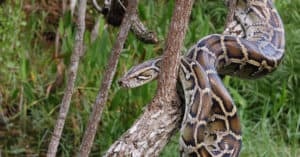Introduction
When it involves venomous snakes, Australia is home to some of the most What are the most venomous snakes in Australia fascinating and hazardous types on the planet. Amongst these, the Tiger Snake attracts attention not only for its powerful poison however likewise for its intriguing habits. Comprehending the behavior of venomous serpents like the Tiger Serpent is crucial for both wildlife fanatics and those living in locations where these snakes exist. This write-up delves into various facets of Tiger Snake behavior, environment, identification, safety measures, and emergency treatment practices in instance of a serpent bite.
Understanding the Behavior of Venomous Snakes Like the Tiger Snake
The Tiger Snake, scientifically known as Notechis scutatus, is notorious for its hostile nature when endangered. These snakes show a variety of actions that can be fairly various from their non-venomous equivalents.
Characteristics of Tiger Snakes
The Tiger Snake is easily well-known as a result of its distinct bands or stripes that appear like a tiger's markings. They can vary in shade from yellowish-brown to dark olive or black. This coloration serves not just as camouflage however additionally as a caution signal to possible predators.
Adaptability to Environment
One exceptional aspect of their habits is their flexibility to various environments. Located largely in seaside areas, marshes, and wetlands throughout Australia and Tasmania, they can prosper in varied habitats including metropolitan locations.
Hunting Techniques
Tiger Serpents are ambush killers mostly feeding upon fish, frogs, and tiny animals. They have keen vision and an acute feeling of smell which assists them in finding victim effectively.
Venom Composition
Their poison consists of neurotoxins that influence the nerve system, causing paralysis or fatality in smaller sized animals. How to identify Australia's deadliest snakes For people, prompt clinical interest is critical after a tiger snake bite as a result of its potentially dangerous effects.
Natural Habitat of Tiger Snakes
Preferred Locations
Understanding where these serpents reside sheds light on their behavior patterns. The tiger serpent habitat includes:

- Coastal regions Swamps Grasslands Urban areas with bountiful water sources
Seasonal Movements
During warmer months, Tiger Snakes are extra energetic as they bask in sunshine or hunt for food. On the other hand, cooler months see them pulling away into hibernation sites.
Are Tiger Snakes Venomous?
Yes! The concern "are tiger snakes venomous?" frequently develops amongst those not familiar with this species. Their poison is taken into consideration among the most dangerous among all serpent varieties worldwide.

Symptoms of a Tiger Serpent Bite
If bitten by a tiger serpent, symptoms might include:

- Localized pain Swelling at the bite site Nausea and vomiting Sweating and confusion
Immediate medical aid is vital as untreated bites can cause severe health and wellness difficulties or even death.
First Aid for Serpent Bites: Quick Feedback Guide
Knowing how to provide emergency treatment for a serpent bite can save somebody's life. Below's what you need to do:
Step 1: Remain Calm
Keeping calm helps decrease heart rate which lowers poison spread.
Step 2: Incapacitate the Affected Area
Keep the influenced limb still and below heart degree if possible.
Step 3: Call Emergency Services
Always seek professional medical help right away after a serpent bite.
First Aid for Snake Bite Package Essentials
A fully equipped snake bite emergency treatment kit need to consist of:
- A compression bandage Antiseptic wipes A set of scissors An ice bag
Safety Safety measures: Protecting against Snake Bites in Australia
Awareness Programs
Educating neighborhoods concerning local serpent species and their behaviors can dramatically minimize encounters causing bites.
Avoiding Dangerous Areas
Staying away from long lawn during warmer months lessens contact with serpents that may be resting or hunting.
Common Mistaken beliefs Regarding Tiger Snakes
Many people believe misconceptions regarding the actions of tiger snakes result in unnecessary worry. Below are some information:
Myth 1: All Tigers Are Aggressive
Not all tiger serpents will certainly present aggression if left undisturbed; numerous favor fleeing as opposed to confrontation.
Myth 2: They Chase Humans
Tiger serpents do not proactively chase humans; they might strike when they feel threatened however will generally retreat if provided space.
Conservation Initiatives Connected to Poisonous Snakes
Conservation initiatives focus on educating areas about protecting neighborhood wild animals while decreasing human-snake interactions.
Importance of Ecosystems
Understanding that venomous snakes play an important function in preserving ecological equilibrium assists foster appreciation rather than worry towards them.
FAQs About Tiger Snakes
What should I do if I encounter a tiger snake?- Maintain distance and slowly pull back without sudden movements.
- While attacks aren't extremely usual because of awareness efforts, they still occur annually within Australia.
- Baby tiger serpents can provide full dosages of venom despite being smaller; therefore caution is suggested around them.
- They mainly eat frogs, fish, little creatures like rats, and other reptiles.
- It's prohibited in most jurisdictions without proper licensing due to security concerns regarding their venom.
- Wear sturdy boots and stay on significant trails; look prior to positioning hands or feet into concealed rooms like rocks or logs.
Conclusion
Understanding the behavior of poisonous snakes like the Tiger Serpent not just boosts our expertise however also promotes safety awareness amongst those living near their habitats. From acknowledging their attributes, understanding first aid methods adhering to a bite, via involving conservation efforts-- every aspect plays an essential role in fostering coexistence with these fascinating reptiles while valuing their location within our ecosystem.
As we deepen our understanding with education and experience, we contribute positively towards guaranteeing both human security and wild animals conservation-- benefitting all parties involved!